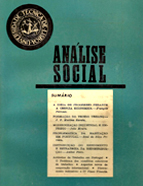

................................
The period considered here (1963-1974) covers a total of 40 issues published (Vol. I, no. 1, January 1963 to Vol. X, no. 40, December 1973). It should be noted that, despite indicating a date prior to the April 1974 Revolution, issue no. 40 was only printed in March 1975. Its director was almost always José Pires Cardoso, a jurist, politician and professor of commercial and corporate law with strong links to the authoritarian political regime of the Estado Novo, having even held the position of Minister of the Interior for two short months in 1958. His political protection and cover were crucial for Análise Social to consolidate itself as an editorial project associated with an innovative research institution in the field of social sciences. In fact, GIS and Análise Social were established after the closure of Revista do Gabinete de Estudos Corporativos (1949-1961), also directed by José Pires Cardoso, seeking to eliminate the ideological constraints of an institution designed to legitimise a renewed model of economic and social corporatism. The new institutional framework provided by the GIS (formally created in 1962 under the ISCEF) created favourable conditions for a significant shift in the approach to contemporary social issues, exploring a critical view of the situations of economic and social underdevelopment diagnosed by GIS members. To this end, they drew on the teachings and tools provided by the social sciences, while maintaining a formal directive solution that tolerated a research programme that was potentially disruptive to the established order.
Although José Pires Cardoso was listed as director of Análise Social until early 1973, the main mentor and driving force behind GIS and its magazine was, from its inception, Adérito Sedas Nunes. His links to Catholic university organisations and his commitment to cultivating the theoretical and methodological modernity of the social sciences contributed to the recognition of his undisputed leadership of this innovative intellectual project. After a year as deputy director (from Vol. IX, No. 33, 1972, which marked the start of a “new series” with a new cover design), Sedas Nunes took over in 1973 (Vol. X, No. 38) as director of the magazine he had conceived and promoted since its inception. It was also when Sedas Nunes became director that Análise Social began to include on its back cover the names of a four-member Editorial Board composed of GIS members (including the director).
This work is financed by national funds through FCT - Foundation for Science and Technology, I.P, in the scope of the projects UIDB/04311/2020 and UIDP/04311/2020.
